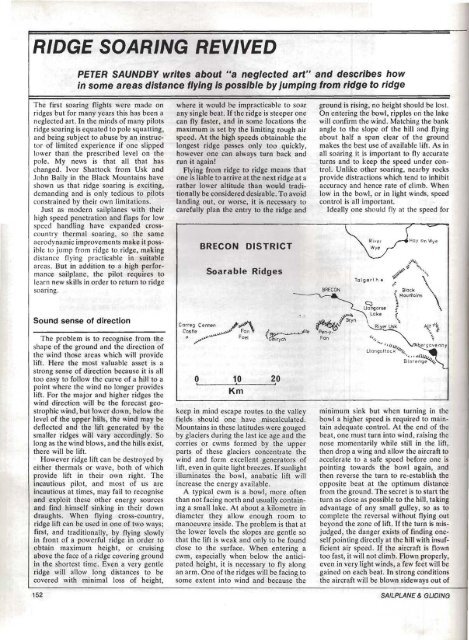Volume 34 No 4 Aug-Sept 1983.pdf - Lakes Gliding Club
Volume 34 No 4 Aug-Sept 1983.pdf - Lakes Gliding Club
Volume 34 No 4 Aug-Sept 1983.pdf - Lakes Gliding Club
- No tags were found...
You also want an ePaper? Increase the reach of your titles
YUMPU automatically turns print PDFs into web optimized ePapers that Google loves.
RIDGE SOARING REVIVEDPETER SAUNDBY writes about Ha neglected art" and describes howin some areas distance flying Is possible by jumping from ridge to ridgeThe first soaring flights were made onridges but for many years this has been aneglected art. In the minds of many pilotsridge soaring is equated to pole squatting,and being subject to abuse by an instructorof limited experience if one slippedlower than the prescribed level on thepole. My news is that all that haschanged. Ivor Shattock from Usk andJohn BaBy in the Black Mountains haveshown us that ridge soaring is exciting,demanding and is only tedious to pilotsconstrained by their own limitations.Just as modern sailplanes with theirhigh speed penetration and flaps for lowspeed handling have expanded CFOSS-'country thermal soaring, so the sameaerodynamic improvements make it possibleto jump from ridge to ridge, makingdistance flying practicable in suitableareas. But in addition to a high performancesailplane, the pilot requires 10learn new skiJ.ls in order to return to ridgesoaring,Sound sense of directionThe problem is to recognise from lheshape of the ground and the direction ofthe wind those areas which will providelift. Here the most valuable asset is astrong sense of direction because it is alltoo easy to follow the curve of a hill to apoint where the wind no longer provideslift. For the major and higl1er r,idges thewind direction will be ,the forecast geostrophicwind, but lower down, below thelevel of the upper hills, tlile wind may bedeflected and the lift generated by thesmaller ridges will v,ary accordingly. Solong as the wind blows, and the hills exist,there will be lift.However ridge lift can be destroyed byeither thermals or wave, both of whichprovide lift in their own right. Theincawtious pilot, and most of us areincautious at times, may fail to recogniseand exploit these other energy sourcesand find himself sinking in their downdraughts. When flying cross-country,ridge lift can be used in one of two ways;(,irsl, and traditionally, by flying slowlyin front of a powerful ridge in order toob,tain maximum height, or cruisingabove the face of a ridge covering groundIn the shortest time. Even a very gentleridge will allow long distances to becovered with minimal loss of height,where it would be impracticable to soarany single beat. If the ridge is steeper onecan fly faster, and in some locations themaximum is set by the limiting rough airspeed. At the high speeds obtainable thelongest ridge passes only too quickly,however one can always turn back andrun it again!Flying from ridge to ridge means thatone is liable to arrive at the neJ(1 ridge at arather lower altitude than wou'd traditionallybe considered desirable. To avoidlanding out, or worse, it is necessary tocarefully plan the entry to the ridge andọBRECONSoarable Ridg,es10 ,KmDISTRICTkeep in mind escape routes to the valleyfields should one have miscalculated.Mountains in these latitudes were gougedby glaciers during the last ice age and thecarries or cwms formed by the upperparts of these glaciers concentrate thewind and form excellent generators oflift, even in quite light breezes. If sunlightilluminates the bowl, anabatic lift willincrease the energy available.A typical cwm is a bowl, more oftenthan not facing north and usually containinga small lake. At about a kilometre indiameter they allow enough room tomanoeuvre inside. The problem is that atthe lower levels the slopes are gentle sothat the lift is weak and only to be foundclose to the surface. When entering acwm, especially when below the anticipatedheight, it is necessary to fly alongan arm. One of the ridges will be facing tosome extent into wind and because theground is rising, no height should be lost.On entering the boWl!, ripples on the lakewill confirm the wind. Matching the bankangle to the slope of the hill and flyingabout half a span clear of the groumdmakes the best us,e of availab'le lift. As ,inall soaring it is important to fly accurateturns and to keep' the speed under control.Unlike other soaring, nearby rocksprovide distractions which tend to inhibitaccuracy and hence rate of climb. Whenlow in the bowl, or in light winds, speedcontrol is all important.Ideally one should fly at the speed for\:i:/ -,,\tCl,.,~-$' 0",~ ~."Talggrlho ", \.~ River -Lay on:eBRECON .' Black "L~ors.~t•. ~"'" Lake ~Bryn \ \~Llongottock u/~~~;~20 .':, Mountains "\\lVer Usk AJlt ,,~..,,~ Pen-y~ \ .•~~Gihirych Fon
















